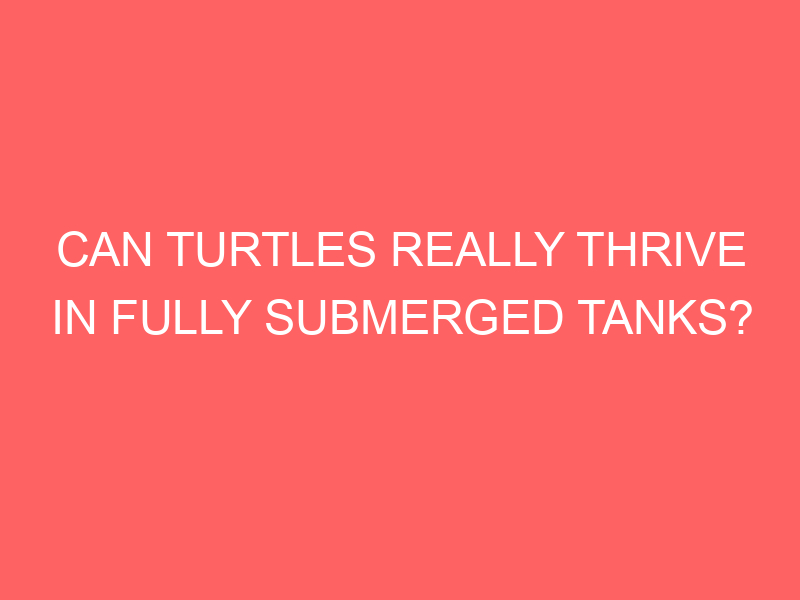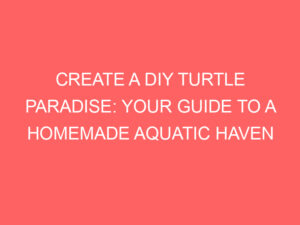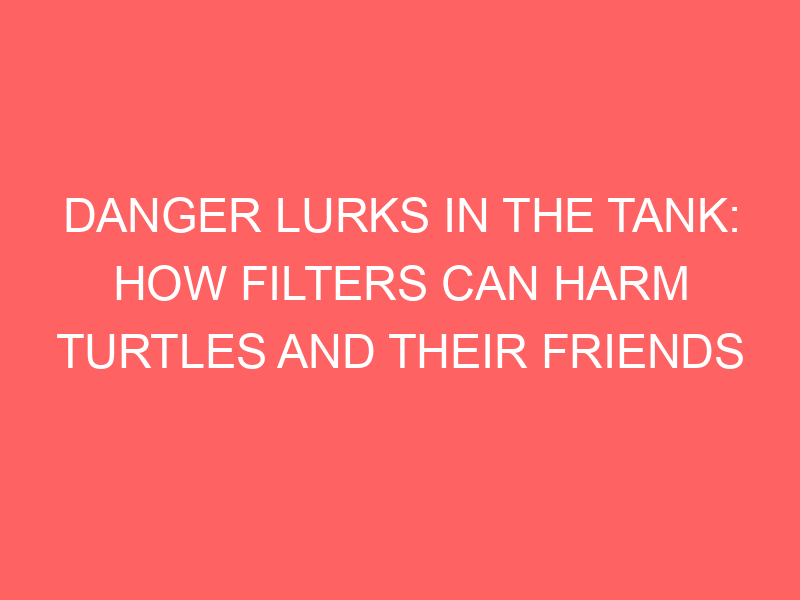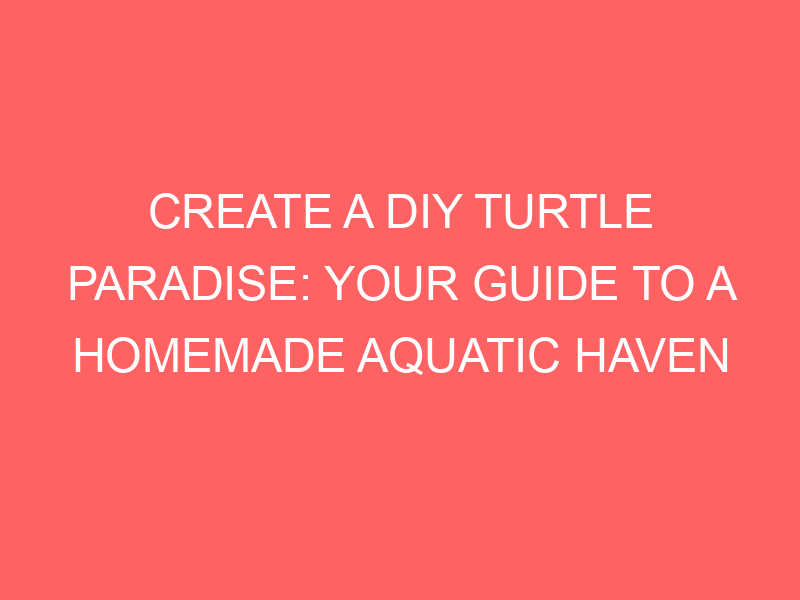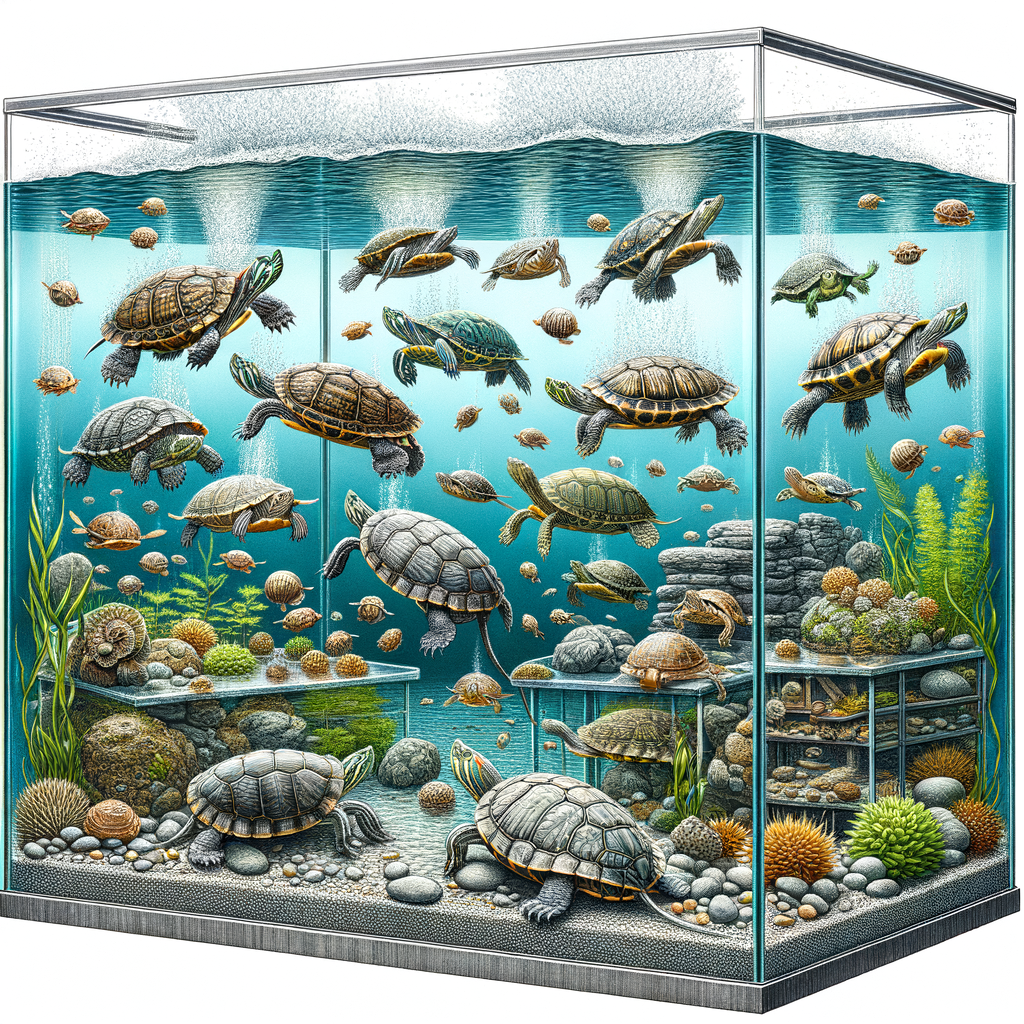
Introduction to Turtles in Submerged Tanks
Welcome to our deep dive into the fascinating world of turtles in submerged tanks. This guide aims to provide you with a comprehensive understanding of this topic, ensuring you can create an optimal environment for your shelled friends.
- Overview of the Topic
- Importance of Understanding Turtle Habitats
Turtles are unique creatures that can thrive both on land and in water. However, certain species of turtles, such as the Red-Eared Slider and the Painted Turtle, prefer living in water-logged environments. These turtles require submerged tanks, also known as aquatic turtle tanks, to mimic their natural habitats. In these tanks, most of the space is filled with water, with a small portion dedicated to a dry basking area.
Understanding the habitat needs of your turtle is crucial for its health and longevity. Turtles in submerged tanks need specific conditions to thrive. These include the right water temperature, proper filtration, adequate lighting, and a balanced diet. By replicating their natural habitat as closely as possible, we can ensure our turtles live happy, healthy lives.
As we dive deeper into this topic, we will explore the intricacies of fully submerged turtle tanks, take a closer look at water-logged turtles, and discuss the setup and maintenance of aquatic turtle tanks. So, whether you’re a seasoned turtle keeper or a curious beginner, this guide is sure to provide you with valuable insights.
Understanding Fully Submerged Turtle Tanks
When it comes to creating a comfortable and natural habitat for your pet turtle, fully submerged turtle tanks are an excellent choice. Let’s delve deeper into understanding what these tanks are and the different types available.
What Are Fully Submerged Turtle Tanks?
Fully submerged turtle tanks, as the name suggests, are aquariums designed to mimic the aquatic environment turtles thrive in. These tanks are completely filled with water, providing turtles with the opportunity to swim freely and behave as they would in their natural habitats.
- Definition of fully submerged turtle tanks: A fully submerged turtle tank is a type of turtle habitat that is entirely filled with water. It is designed to replicate the natural aquatic environment of turtles, allowing them to swim, dive, and explore freely. These tanks usually come with a basking area where turtles can rest and soak up heat and UV light, essential for their health and well-being.
- Types of fully submerged turtle tanks: There are several types of fully submerged turtle tanks, each designed to cater to different species of turtles and their specific needs. The most common types include:
- Standard Turtle Tanks: These are the most common type of turtle tanks and are suitable for most turtle species. They come in various sizes and often include a basking area.
- Reef Tanks: These tanks are designed for sea turtles and include features like live rocks and corals to mimic a natural reef environment.
- Paludariums: A combination of an aquarium and a terrarium, these tanks have both a fully submerged area and a land area, making them ideal for semi-aquatic turtles.
Choosing the right type of fully submerged turtle tank depends on the specific needs of your pet turtle. It’s important to consider factors like the turtle’s size, species, and natural habitat when making your selection.
Pros and Cons of Fully Submerged Turtle Tanks
When it comes to creating a home for your pet turtle, one option is a fully submerged tank. This type of tank has its own set of benefits and challenges. Let’s take a closer look at them.
- Benefits of Submerged Tanks for Turtles
Fully submerged tanks can provide a more natural environment for turtles, especially for species that are primarily aquatic. Here are some of the key benefits:
- Swimming Space: Turtles love to swim. A fully submerged tank gives them plenty of room to do so, which can contribute to their overall happiness and health.
- Temperature Control: Water in the tank can help regulate the temperature, making it easier to maintain the right conditions for your turtle.
- Exercise: The extra swimming space can also provide a good source of exercise, which is important for a turtle’s physical well-being.
- Potential Drawbacks and Challenges
While there are many benefits to fully submerged turtle tanks, there are also some potential drawbacks and challenges to consider:
- Maintenance: Fully submerged tanks can require more maintenance. For example, you’ll need to monitor and adjust the water quality regularly to keep your turtle healthy.
- Cost: These tanks can be more expensive to set up and maintain. This includes the cost of the tank itself, as well as ongoing costs for things like water filters and heaters.
- Space Requirements: Fully submerged tanks typically need to be larger than other types of turtle tanks, which can be a challenge if you’re limited on space.
In conclusion, fully submerged turtle tanks have both pros and cons. It’s important to weigh these factors carefully when deciding on the best home for your pet turtle.
Water-logged Turtles: A Closer Look
Let’s dive deeper into the fascinating world of turtles and their life underwater. Turtles are remarkable creatures that have adapted to survive in various environments, including underwater. But how do they do it? Let’s explore.
How Turtles Adapt to Living Underwater
Turtles have developed a range of physical and behavioral adaptations that enable them to live and thrive underwater. Let’s take a closer look at these adaptations.
- Physical adaptations of turtles for underwater living
- Behavioral adaptations of turtles in water
Turtles have a unique physical structure that allows them to live comfortably underwater. Their streamlined bodies and webbed feet make them excellent swimmers. The hard shell protects them from predators and helps them withstand the pressure of deep water. Additionally, turtles have a special respiratory system that allows them to absorb oxygen directly from the water through their skin, throat, and cloaca when they are submerged for extended periods.
Aside from their physical adaptations, turtles also exhibit behavioral adaptations that help them survive underwater. They can slow down their heart rate to conserve oxygen, allowing them to stay underwater for longer periods. Turtles also have the ability to sense changes in water pressure, which helps them navigate and find food underwater. Furthermore, they are known to burrow into the mud at the bottom of bodies of water during colder months, a behavior known as brumation, which is similar to hibernation.
These physical and behavioral adaptations have allowed turtles to thrive in a variety of aquatic environments, from freshwater ponds and lakes to the open ocean. The next time you see a turtle gliding effortlessly through the water, remember the amazing adaptations that make it possible.
Case Study: Turtles Thriving Underwater
Let’s dive into some real-life examples of turtles living happily in submerged tanks and the important lessons we can learn from these cases.
- Real-life examples of turtles thriving in submerged tanks
- Key takeaways from these case studies
One shining example of a turtle thriving underwater is that of a Red-Eared Slider named Tommy. Tommy’s owner, a marine biologist, created a fully submerged tank environment for him. Tommy quickly adapted to his new home, spending most of his time exploring the tank and enjoying the underwater plants and rocks. He even developed a fondness for swimming against the tank’s gentle current, demonstrating his comfort and happiness in the water.
Another example is a group of Painted Turtles at a local school. The school’s science teacher set up a large submerged tank for these turtles. The students observed the turtles’ behavior and noted their active and healthy lifestyle. The turtles were seen basking under the tank’s UV light, swimming energetically, and feeding enthusiastically on a diet of aquatic plants and small fish.
These real-life examples provide valuable insights into the successful care of turtles in submerged tanks. Here are the key takeaways:
| Key Takeaways |
|---|
| Turtles can adapt well to fully submerged environments if given time and appropriate care. |
| Providing a variety of underwater elements, like plants and rocks, can enhance a turtle’s quality of life. |
| Regular monitoring of a turtle’s behavior can help identify its comfort levels and overall health. |
| Education and awareness about proper turtle care can contribute to their successful upkeep in submerged tanks. |
In conclusion, with the right environment and care, turtles can not only survive but thrive in submerged tanks. These case studies serve as a testament to this fact and provide valuable lessons for anyone considering creating a submerged tank for their pet turtle.
Aquatic Turtle Tanks: Setup and Maintenance
Creating a comfortable and safe environment for your aquatic turtle is crucial for its health and happiness. This involves setting up a submerged turtle habitat that mimics their natural environment as closely as possible. Let’s dive into the steps you need to follow to create the perfect underwater home for your turtle.
Setting Up a Submerged Turtle Habitat
Setting up a submerged turtle habitat involves two main steps: choosing the right tank and creating an ideal underwater environment. Let’s explore these steps in detail.
- Choosing the right tank
- Creating an ideal underwater environment
The first step in setting up a submerged turtle habitat is choosing the right tank. The size of the tank depends on the size and species of your turtle. As a general rule, for every inch of turtle shell, you should provide 10 gallons of water. For example, a turtle with a 5-inch shell would require a 50-gallon tank. The tank should be large enough for your turtle to swim and dive freely. It should also have a dry area where your turtle can bask under a heat lamp.
Once you have the right tank, the next step is to create an ideal underwater environment. This involves setting up the right water temperature, providing proper lighting, and adding appropriate decorations. The water temperature should be kept between 75 and 85 degrees Fahrenheit for most turtle species. The tank should have a UVB light to help your turtle produce vitamin D3, which is essential for its health. Decorations like rocks, plants, and hiding spots can make your turtle feel more at home. Remember to keep the tank clean by installing a good filtration system and changing the water regularly.
In conclusion, setting up a submerged turtle habitat requires careful planning and attention to detail. By choosing the right tank and creating an ideal underwater environment, you can provide your aquatic turtle with a home that promotes its health and well-being.
Maintaining Water Conditions for Turtles
One of the most crucial aspects of keeping a turtle healthy and happy in its tank is maintaining the right water conditions. This involves two key areas: understanding the importance of water quality and implementing best practices for maintaining these conditions.
- Importance of Water Quality in Turtle Tanks
Water quality is paramount for the health of your turtle. Turtles, especially those living in fully submerged tanks, spend most of their time in water. Therefore, the quality of this water directly affects their health and wellbeing.
Bad water quality can lead to various health issues for turtles. These include skin and shell infections, respiratory problems, and even blindness. A study showed that turtles living in poor water conditions were twice as likely to develop health problems compared to those in clean water.
Moreover, turtles are sensitive to changes in water temperature and pH levels. Sudden changes can cause stress, leading to a weakened immune system and increased susceptibility to diseases.
- Best Practices for Maintaining Water Conditions
Now that we understand the importance of water quality, let’s look at some best practices for maintaining optimal water conditions in your turtle tank.
| Best Practice | Description |
|---|---|
| Regular Water Changes | Change about 25% of the tank’s water every week. This helps remove waste and toxins, keeping the water fresh and clean. |
| Use of Water Conditioners | Water conditioners can neutralize harmful chemicals like chlorine, making tap water safe for your turtle. |
| Monitoring Water Temperature | Keep the water temperature consistent, ideally between 75-85°F (24-29°C). Use a water heater if necessary. |
| Checking pH Levels | Ensure the water’s pH level is between 6.0 and 8.0. Use a pH test kit to monitor this regularly. |
By following these best practices, you can create a healthy and comfortable environment for your turtle to thrive in. Remember, a happy turtle is a healthy turtle!
Conclusion: Underwater Living for Turtles
In this article, we have explored the fascinating world of turtles living in fully submerged tanks. Let’s take a moment to recap the key points we’ve discussed and share some final thoughts on this topic.
- Recap of key points discussed
- Final thoughts on turtles in fully submerged tanks
We began by introducing the concept of turtles in submerged tanks, highlighting the importance of understanding the unique needs of these aquatic creatures. We then took a closer look at water-logged turtles, discussing their behavior, diet, and habitat requirements.
Next, we delved into the specifics of setting up and maintaining an aquatic turtle tank. We discussed the importance of water quality, temperature control, and providing the right diet for your turtle. We also highlighted the need for a safe and comfortable environment, including hiding spots and basking areas.
Keeping turtles in fully submerged tanks can be a rewarding experience, but it requires a commitment to understanding and meeting their specific needs. Turtles are fascinating creatures, and providing them with a suitable underwater home can help them thrive and live a long, healthy life.
Remember, every turtle is unique, and what works for one may not work for another. It’s crucial to monitor your turtle’s behavior and health regularly and adjust your care routine as needed. With patience, dedication, and the right knowledge, you can create a thriving underwater habitat for your turtle.
As the famous naturalist John Muir once said, “In every walk with nature, one receives far more than he seeks.” This is certainly true when it comes to caring for turtles in fully submerged tanks. We hope this article has provided you with valuable insights and guidance on this rewarding journey.

